The occurrence of pool pump problems usually does not go unnoticed. Unusual noises appear, and the device starts working jerkily or stops working altogether. Any changes in operation should be considered as a sign, alerting you to the occurrence of some problems.
A pool pump is an essential part of any pool plumbing system. This equipment creates the necessary pressure that makes the water move and passes through the filter. You could say that it is the heart of your swimming pool. Without it, the crystal clear water will quickly become turbid, bloom, and, over time, harmful microorganisms will multiply. That is why you need carefully monitor the proper operation of the pump. Unfortunately, this equipment, like any other, can periodically fail.
In this article, we will look at the most common pool pump problems that occur with it and tell you how to troubleshoot them. But first, you need to understand how the pump works to know where to look for the problem.
How the pool pump works
The pump has the function of circulating the water in the pool — so it does not stagnate. It also runs the water through the filters for cleaning. Most of the time, the pump and the filter are single units. Separately, they are more commonly available as a spare part. Previously on our website, we have already written about how to choose a swimming pool pump.
The principle of the pool pump is elementary. It connects by hoses to the filter and the skimmer — a device that cleans the upper layer of water from various floating debris.
- Once the pump turns on, water is drawn from the pond through the skimmer, picking up large debris that retains by the skimmer’s screen.
- The pump’s cleaning chamber sifts out medium-sized particles.
- Then the liquid goes to the filtration chamber, where the water is cleaned of all remaining inclusions and impurities.
- Then the refreshed water returns to the bowl through the nozzle, the blades of which rotate.
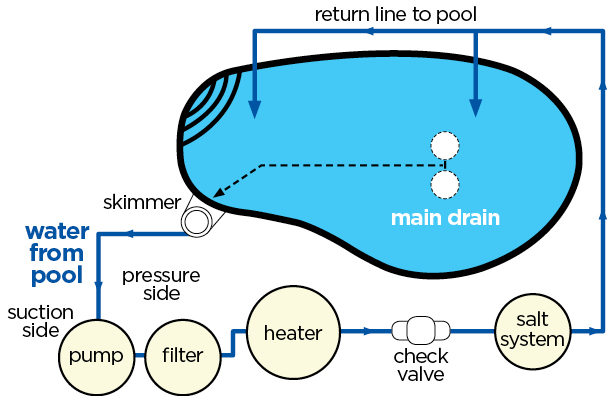
The water inlet and outlet of the system should be located at opposite ends of a pool for maximum efficiency. Such circulation allows you to keep the water clean and clear and rid of all unwanted pollution: leaves, small debris, bacteria, traces of their life, etc.
How to troubleshoot pool pump problems
Improper operation, sudden voltage fluctuations in the network, and mechanical impacts — this is not a complete list of factors that cause the malfunction of the pool pump. The malfunction can be determined by several characteristic signs, a brief list of which we will consider below.
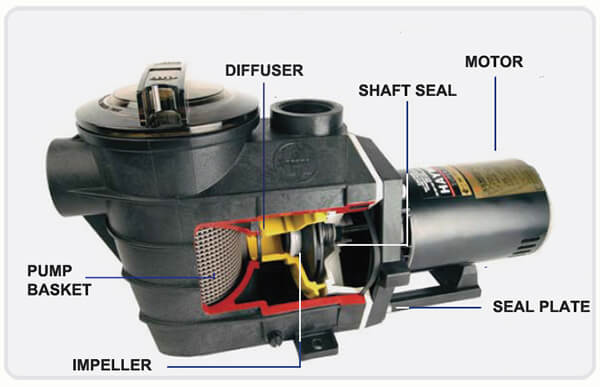
No-suction problem
If your pump is not moving water, you should check the skimmer and pump baskets to make sure they are empty and not restricting water flow. Then make sure your pool filter is clean — a dirty filter can also impede flow. Once you’ve checked this, you can check the pump impeller — a motor-driven water suction disk. It is a part of the pump that connects to the motor and responsible for moving the water. Impellers will get clogged from time to time, especially in the spring. To inspect the impeller, open the pump to see inside the impeller housing or volute.
Low-pressure problem
In some cases, the pump fails to deliver water to the system. The cause of the failure may be due to clogging of the system, as a result of which the water flow rate is drastically limited. Do the same as the previous problem — check the skimmer and filter baskets, pump impeller, and other elements, open the pump, and clean debris.
Another common cause of the malfunction is an air leak in the suction line. Since air has a much lower density than water, the pump will suck up only gas, which reduces the motor output. Causes of water leakage can be due to a worn impeller housing o-ring, a poor shaft seal, or a broken thread sealant or shrinkage thread on the drain pipe.
Also, the problem with weak pressure can be related to a defective diffuser, which we will talk about below.
Diffuser problem
The diffuser is a narrow tube that directs water from the filter basket to the impeller.
Usually, parts like the diffuser and impeller last longer than the motor. But due to dirt and untimely cleaning, they can fail prematurely. A more common problem with the diffuser is a missing or damaged gasket or o-ring. But you can solve this problem without a technician — with the help of our instructions. You can use it to change the diffuser itself or its gasket.
- The first thing to do is to disconnect the pump from the power supply using the switch on the switchboard next to the timer.
- The next step is to release pressure to a pressure gauge reading of 0 psi. To do this, turn the pressure relief valve counterclockwise, which is located at the top of the filter.
- Unscrew the four bolts on the pool pump housing that connect the pump assembly and housing. And pull the assembly out of the housing.
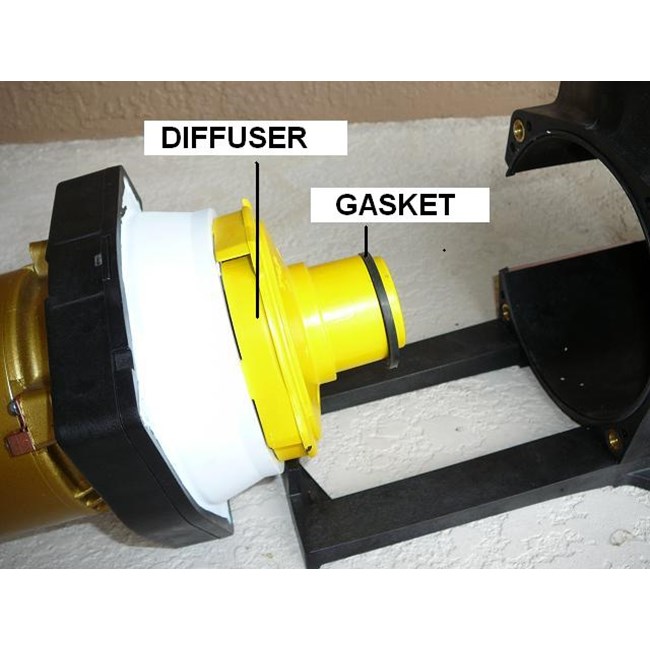
- Now you should see the diffuser and its gasket. Remove the part from the assembly – it should snap off easily.
- Replace the diffuser or gasket (depending on your needs) and apply a new coat of grease to the gasket.
- Snap the diffuser back into place so that the lettering “Top” matches it and the sealing plate.
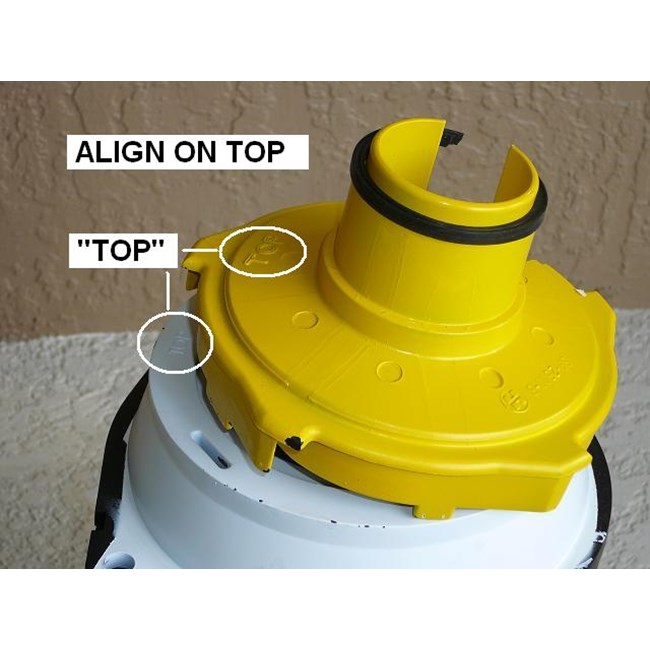
- Reassemble the motor in the same way as you disassembled it.
- Fill the pump by flooding the filter with water.
- Turn the power back on. Close the safety valve at the top of the filter and wait for the water to come out.
Clock problem

The most common problem is a broken timer motor which can cause the pump not to work. It can be affected by prolonged use, water, and overheating. The only sure way out is to buy a new timer.
It is also widespread for the timer to go off due to power outages. It is necessary to set the same settings and time as the power failure. To do this, you need to pull the timer dial toward you and twist it to set the desired time.
Also, you may have the wrong time of day set (mixed up AM and PM), and you don’t know that your pump is running. Here’s what you need to do in that case:
- Remove the timer trippers from the clock.
- Pull the timer dial toward you and twist it until the right time aligns with the current timestamp (the silver or gold pointer at the top of the watch).
- Apply the trippers for the desired on and off times.
- Turn on the clock.
Air problem

Air in the pool pump is also a common problem when you see air bubbles coming out of the return jets. We want to make you happy — this is not a critical problem and is easily solved.
The first thing to do is to check the water level in the pool. If there is not enough water, the skimmer will skim not only the water but also the air. The ideal level is when the water line is in the middle of the skimmer inlet.
Also, check the skimmer basket to make sure it is not damaged and properly installed. And if you have a weir at its inlet, check it — it should move freely.
If these steps do not help, go directly to checking the pump itself. Its cover should be intact — if it is not, replace it. The next vulnerable point is the O-ring. To check it, turn off the pump, remove the cover and inspect the O-ring for cracks by bending it off. If it is in good condition, spray it with Teflon-based grease before putting it back on to create a better seal and prevent it from drying. If you notice cracks, replace it with a new one, also lubricated.
Check the drain plugs on the pump casing. They must be tight and leak-free. You can use a plumber’s tape to seal them by wrapping it around the threads.
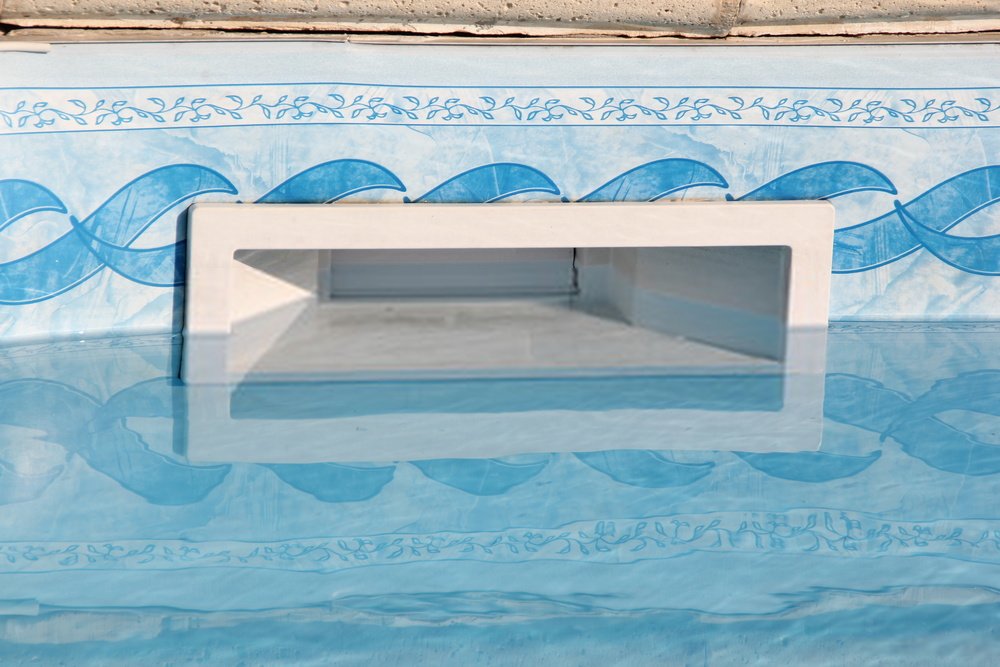
If you have an inground pool, we recommend you also check the connections in the plumbing. Check all o-rings for cracks and whether they are correctly in place. Otherwise, air can get into the system due to leakage.
Instructions for the pool pump use
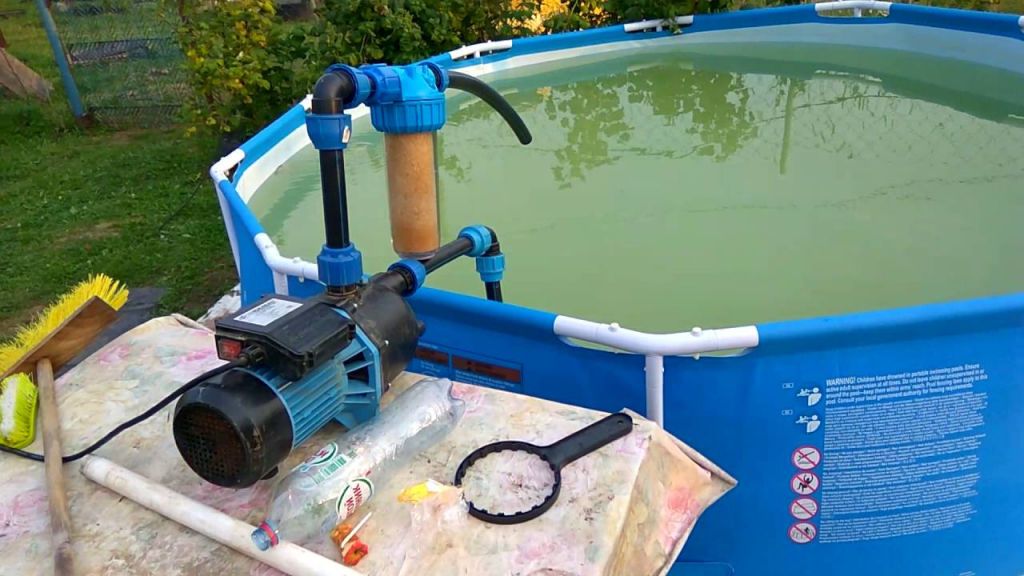
To keep your pool clean, you need to run the pump at least once a day for about 8-12 hours. After 6-7 hours of running the pump, you will be able to use perfectly clean water in your pond. It is advisable not to swim during filtration so as not to interfere with the cleaning process, so often the pump runs at night. That said, the best time to run the pump is during the hottest part of the day when algae start to multiply a lot. You can also read our tips on how to keep a small pool clean in our article.
Once every 7-10 days the filter must be run in reverse to remove accumulated contamination and eliminate the possibility of clogged ducts. When changing the pool pump mode, it is extremely important — to turn it off first and then perform the necessary operations.
Summary
A pool pump is responsible for creating the pressure in your pool that makes the water flow through the filter. Think of it as the heart of your swimming pool — without a filter and pump, your sparkling water will quickly turn into a muddy pond.
Unfortunately, there are times when there are problems with a pump, and it doesn’t work properly, and there can be many reasons. In this article, we looked at the most common pool pump problems and their solutions — from electrical to air problems.
FAQ
👨🔧How do you troubleshoot a pool pump?
If the pump is not out of warranty, the best solution is to take it to a service center for repair. If the warranty is not valid, you first need to determine which part of the pump is the problem and fix it according to the instructions in our article.
🔎How do you know if your pool pump motor is bad?
The most common manifestation of a broken motor is the sound it makes. If you hear a grinding or creaking it is a problem with the bearings — they need to be replaced. If the motor starts to hum strangely, the problem lies in the capacitor, which provides the charge so that the motor runs steadily. It can also be replaced separately. If you hear pops and clicks, it is worth checking the electrical failure inside the pump.
🔧What causes a pool pump to stop working?
There can be many reasons: the pump can be clogged with debris, so never forget to clean it. It could also be a problem with a timer that is not properly installed or damaged wires.
⌛How long should a pool pump last?
On average, pool pumps can last from 7 to 12 years, depending on operating conditions. To extend its service life, clean the skimmer basket and filter at regular intervals, check the o-rings and lubricate if necessary. The manufacturers also recommend running the pump for more than 6 hours a day (8-12 hours) and making sure it does not overheat.
🔥How do you know if your pool pump is burnt out?
One sure sign that your pump is burned out is that it won’t turn on after checking the skimmer, o-rings, and other parts mentioned in our article. Also, if it has stopped turning on recently or it may be hot.
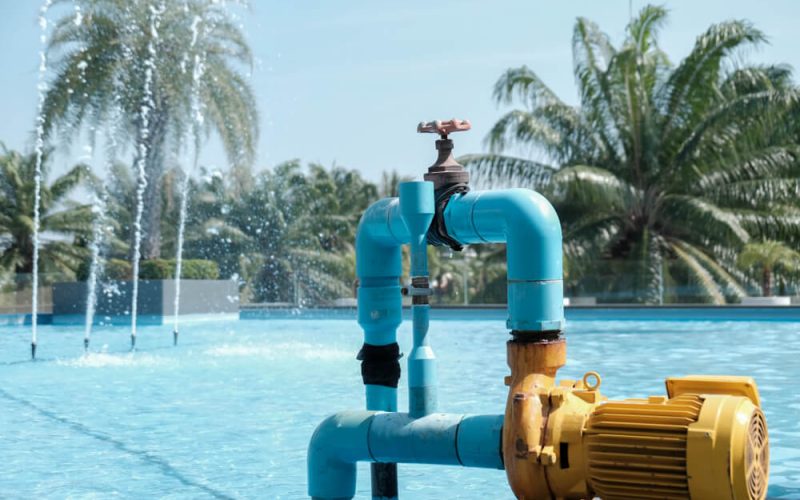


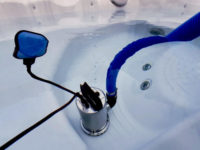
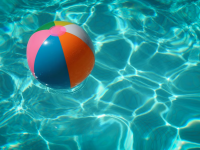
We’re glad that you described how we’d identify a faulty swimming pool pump. I visited my sister’s house last weekend and noticed that her pool pump made some odd noises, so I think she’d read your post right away. Thank you for the information on grinding pool pump motors and their replacement needs.